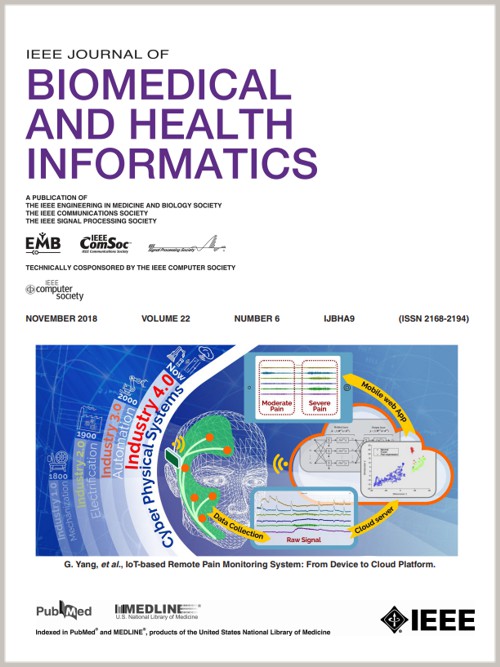Automated Quantification of HER2 Amplification Levels Using Deep Learning
IF 6.8
2区 医学
Q1 COMPUTER SCIENCE, INFORMATION SYSTEMS
IEEE Journal of Biomedical and Health Informatics
Pub Date : 2024-10-09
DOI:10.1109/JBHI.2024.3476554
引用次数: 0
Abstract
HER2 assessment is necessary for patient selection in anti-HER2 targeted treatment. However, manual assessment of HER2 amplification is time-costly, labor-intensive, highly subjective and error-prone. Challenges in HER2 analysis in fluorescence in situ hybridization (FISH) and dual in situ hybridization (DISH) images include unclear and blurry cell boundaries, large variations in cell shapes and signals, overlapping and clustered cells and sparse label issues with manual annotations only on cells with high confidences, producing subjective assessment scores according to the individual choices on cell selection. To address the above-mentioned issues, we have developed a soft-sampling cascade deep learning model and a signal detection model in quantifying CEN17 and HER2 of cells to assist assessment of HER2 amplification status for patient selection of HER2 targeting therapy to breast cancer. In evaluation with two different kinds of clinical datasets, including a FISH data set and a DISH data set, the proposed method achieves high accuracy, recall and F1-score for both datasets in instance segmentation of HER2 related cells that must contain both CEN17 and HER2 signals. Moreover, the proposed method is demonstrated to significantly outperform seven state of the art recently published deep learning methods, including contour proposal network (CPN), soft label-based FCN (SL-FCN), modified fully convolutional network (M-FCN), bilayer convolutional network (BCNet), SOLOv2, Cascade R-CNN and DeepLabv3+ with three different backbones (利用深度学习自动量化 HER2 扩增水平。
在抗 HER2 靶向治疗中,HER2 评估是选择患者的必要条件。然而,人工评估 HER2 扩增耗时、耗力、主观性强且容易出错。在荧光原位杂交(FISH)和双原位杂交(DISH)图像中进行 HER2 分析所面临的挑战包括细胞边界不清晰和模糊、细胞形状和信号差异大、细胞重叠和聚集以及标签稀疏等问题,而人工标注仅针对置信度高的细胞,因此会根据个人对细胞选择的不同而产生主观评估分数。针对上述问题,我们开发了一种软采样级联深度学习模型和信号检测模型,用于量化细胞的CEN17和HER2,以辅助评估HER2扩增状态,帮助患者选择HER2靶向治疗乳腺癌。在对两种不同类型的临床数据集(包括 FISH 数据集和 DISH 数据集)进行评估时,在对必须同时包含 CEN17 和 HER2 信号的 HER2 相关细胞进行实例分割时,所提出的方法在这两种数据集上都取得了较高的准确率、召回率和 F1 分数。此外,该方法还明显优于七种最新发表的深度学习方法,包括轮廓提议网络(CPN)、基于软标签的FCN(SL-FCN)、修正的全卷积网络(M-FCN)、双层卷积网络(BCNet)、SOLOv2、级联R-CNN和具有三种不同骨架的DeepLabv3+(P≤0.01)。在临床上,抗 HER2 治疗也可用于胃癌患者。我们将所开发的模型用于辅助胃癌患者的 HER2 DISH 扩增评估,也显示出了良好的预测结果(准确率分别为 97.67 ±1.46%,精确率分别为 96.15 ±5.82%)。
本文章由计算机程序翻译,如有差异,请以英文原文为准。
求助全文
约1分钟内获得全文
求助全文
来源期刊

IEEE Journal of Biomedical and Health Informatics
COMPUTER SCIENCE, INFORMATION SYSTEMS-COMPUTER SCIENCE, INTERDISCIPLINARY APPLICATIONS
CiteScore
13.60
自引率
6.50%
发文量
1151
期刊介绍:
IEEE Journal of Biomedical and Health Informatics publishes original papers presenting recent advances where information and communication technologies intersect with health, healthcare, life sciences, and biomedicine. Topics include acquisition, transmission, storage, retrieval, management, and analysis of biomedical and health information. The journal covers applications of information technologies in healthcare, patient monitoring, preventive care, early disease diagnosis, therapy discovery, and personalized treatment protocols. It explores electronic medical and health records, clinical information systems, decision support systems, medical and biological imaging informatics, wearable systems, body area/sensor networks, and more. Integration-related topics like interoperability, evidence-based medicine, and secure patient data are also addressed.
 求助内容:
求助内容: 应助结果提醒方式:
应助结果提醒方式:


